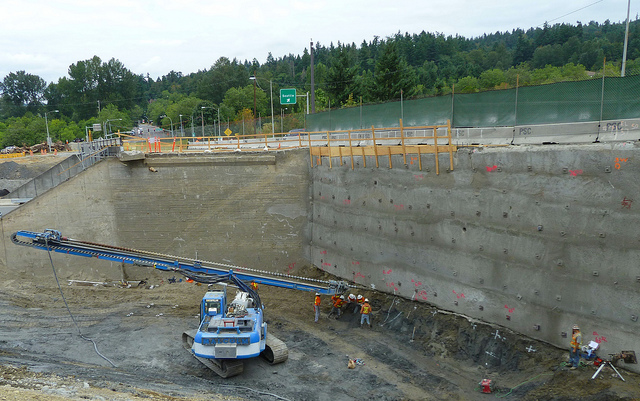
Soil erosion is the leading cause of road failure in areas where stream beds run along existing roadways. Often caused by downpours, rainwater runoff can flood nearby roads, transforming them into impassable waterways. And when overflowing streams saturate the soil on steep slopes, they can precipitate landslides. In the United States, dozens of people die each year from these weather-related events.
What Is Soil Nailing?
A proven earth retention technique, soil nailing is used in areas where erosion and/or landslides are a concern. By inserting large steel bars, “nails,” into the soil mass, the process can promote soil stability on a temporary or permanent basis. Significantly faster than competing methods, soil nailing provides a resisting force against landslides and other types of slope failure. Here’s how it’s done.
Soil Nailing in Practice
When a large section of Berkshire Road in Gates Mills, Ohio failed after a heavy downpour, village officials knew they had to settle the matter once and for all. Because a large stream parallels the roadway, erosion problems had become an ongoing issue. Officials called in the CW Courtney Company to find a cost-effective repair option.
After examining the stream bank and nearby roadway, the company recommended a repair strategy that included soil nailing, floodplain creation, and vegetated rock stabilization. According to the engineers, the project would not only produce the desired results, but it would also save the village between $50,000 and $100,000 over more traditional construction strategies. The project’s timeline would also be shortened from 4 weeks to 2 weeks. After the village approved the project, the CW Courtney Company supervised the proposed repairs.
Soil Nailing Benefits
An increasingly popular option, soil nailing has several advantages over other construction methods, including the following:
– Works in tight spaces
– Minimal shoring needed
– Less construction, resulting in fewer traffic obstructions
– Less impact on the environment
– No restrictions on wall height
– Works with existing wall systems
– Permanent or temporary use
– Compatible with irregular shapes
Potential Limitations
Soil nailing should not be used in every case of roadway erosion. Proper analysis and land surveying will help decide if this solution is the best option. Here are a few possible restrictions:
– Soil contains too much sand, rock, or gravel
– Area is in a high water table
– Sensitive and expansive soils may not provide the stability needed for permanent insertion
Conclusion
In spite of those possible limitations, soil nailing is now a well-established technique. As seen in the case study, it has numerous applications and is most effective in flood-prone areas. Adding stability to these at-risk areas can reduce the risk of roadway failures caused by significant rain events.

